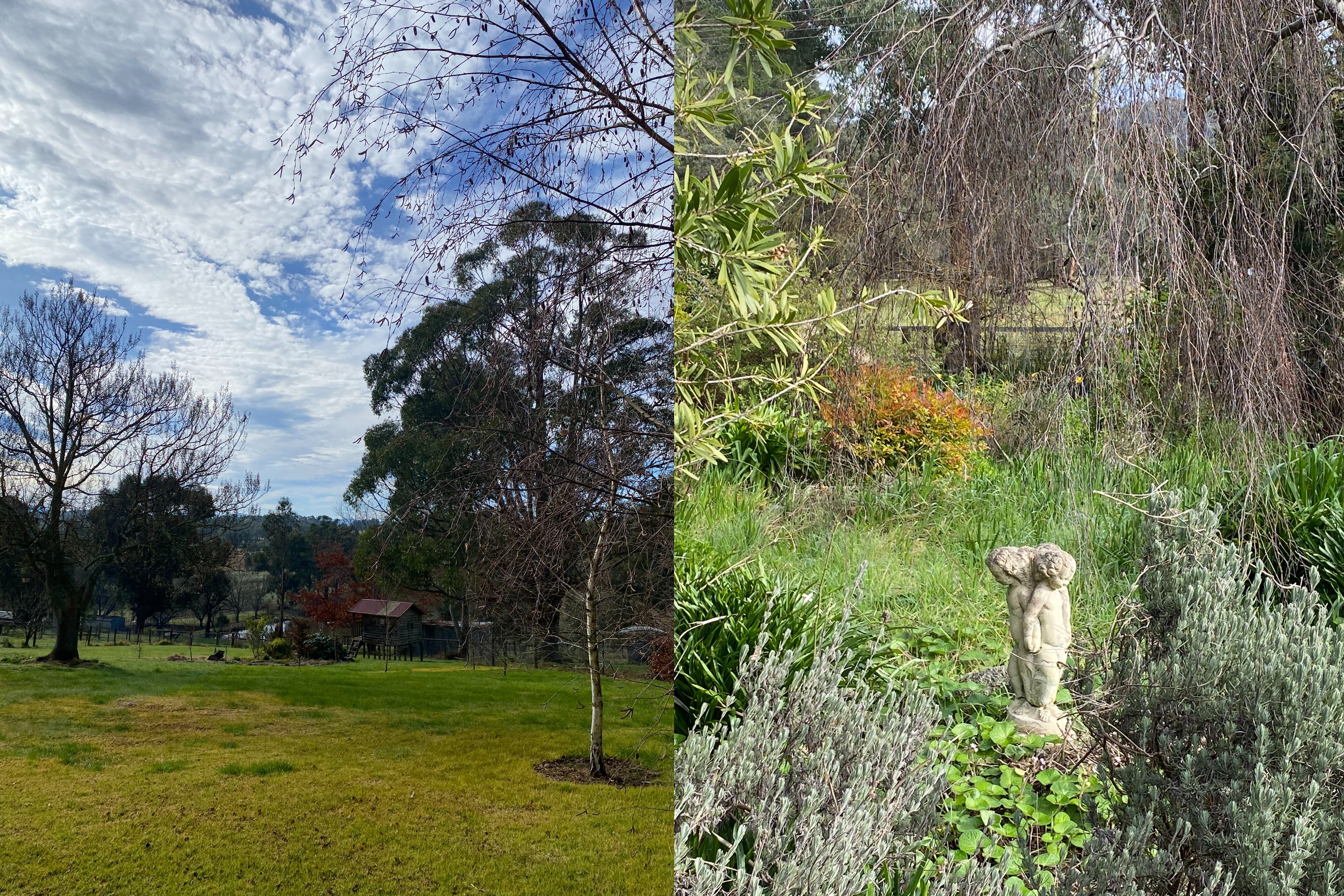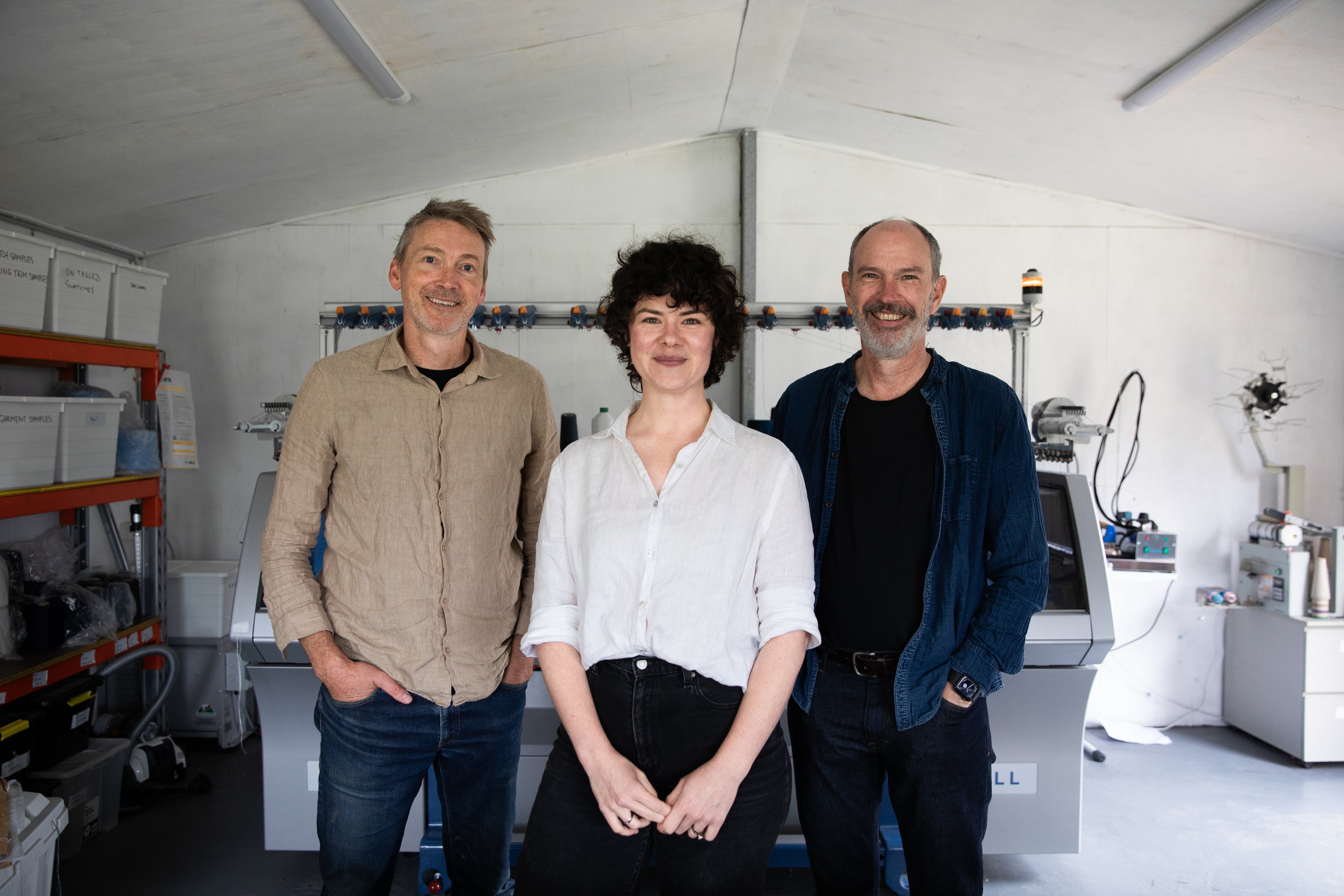We’re always looking for Australian manufacturers we can work with to utilise their waste. So when we came across Hatch & Make’s new knitting studio on Wurundjeri Country in the in the Yarra Valley we were stoked. Rather than using waste, Hatch & Make are committed to working with responsibly sourced wool, and eventually Australian regeneratively grown wool in a close-to-no-waste model. Knitting reduces waste in the making process because only the yarn to make each piece is required, rather than having to deal with an oversupply of fabric production. It also meant we could take a sister trip to visit the studio, and add a wine tour of the famous agricultural region!
 Inside the Hatch & Make studio
Inside the Hatch & Make studio
The knitting studio
Hatch & Make is a small studio tucked away in the rolling hills of Wurundjeri Country, also known as Yarra Valley, about 50 kilometres east of Melbourne. The outfit is run by a team of textiles experts (who we’ll hear from towards the end of this article!) whose mission it is to develop and manufacture premium knitwear in systems where waste is eliminated and nature is regenerated.
Using only 100% natural products and Responsible Wool Standard yarn, with a view to use Australian-grown regenerative wool, Hatch & Make is a driving force for the industry to follow suit. The team develops high-quality products designed to last with the knowledge that what they make can be recycled and even composted at the end of its useful life.
Working with high tech equipment to innovate knits while looking out to vistas of abundant greenery is a constant reminder to align with nature’s systems.
 The view from the Hatch & Make studio
The view from the Hatch & Make studio
Knitting as a reduced-waste manufacturing technique
Machine knitting is a bit like 3D printing – in both cases a string of material is layered following a pattern in order to achieve a certain shape. You only use the material inputs required to make the final products, and in knitting, produce almost no yarn waste.
Hatch & Make use machinery in a flexible production model where high minimums aren’t necessary to create efficiency in running the machinery in the same way industrial weaving equipment requires. It means you aren’t left with sizeable pieces of offcut fabric, that is extra yardage required to set up the machinery, or an oversupply of fabric the client didn’t require.
The machine knitting process
Machine knitting at Hatch & Make begins with a design file, which is fed into a knitwear computer program that indicates how every loop in the fabric is formed to create the overall knit structure. Yarns are then loaded onto the knitting machine, which uses the computer file to produce the knitted fabric.
 Paul, the knitwear technician, working with the computer program and Sammy checking out the knitting machine
Paul, the knitwear technician, working with the computer program and Sammy checking out the knitting machine
The machine selects yarns as dictated by the program and knits one blanket at a time. For us, working with Hatch & Make has allowed for an interactive and iterative design process because we can create single units, making tweaks in between versions. When we weave with industrial weaving looms, we have to produce dozens of units at once, so structure and design experiments are costly!
 A test version of our Dancing Daisies design almost seems like it’s ‘printed out’ from the machine
A test version of our Dancing Daisies design almost seems like it’s ‘printed out’ from the machine
Because the knitting machine is limited in width, sometimes joining is required to create a piece of fabric wider in dimension than the machine itself. This is when the linking machine comes into play, bringing together panels by carefully guiding them through a round, needled mechanism linking with a thread to create a larger whole.
 Karina at the linking machine learning how to bring together two sample panels
Karina at the linking machine learning how to bring together two sample panels
Finally, sample pieces of fabric are compared to the original design to assess product dimensions, design ratios and colour accuracy. The samples are also analysed with performance in mind – how strong is the fabric, how stretchy, soft and cosy does it feel?
We also wash the samples to catch any shrinkage and to ensure the finishes and edges are durable. Once samples look, feel and perform as we wish, it’s time to put the blankets into production on the very same machinery used for testing!
 Measuring a few early-stage sample pieces of knitted fabric well before going into production
Measuring a few early-stage sample pieces of knitted fabric well before going into production
The expert team at Hatch & Make
The team at Hatch & Make have extensive fashion and manufacturing experience and are experts in knitwear development. We spoke with Kirri-Mae at Hatch & Make about the expertise each team member brings to the project. Kirri-Mae says,
‘From decades in the industry, Dave, Nige, Paul and I bring extensive experience across textiles and fashion. We also work with a deep and applied understanding of sustainability and what it means to operate within, and toward, a circular economy. In the Hatch+Make team we bring a real balance to each other! Creative big picture thinking, problem solving, hand skills, day to day building of systems and efficiencies that are crucial in manufacturing... between us we have it all covered.’
 The team at Hatch & Make are working toward better outcomes for textiles in Australia
The team at Hatch & Make are working toward better outcomes for textiles in Australia
We also asked Kirri-Mae what the team hopes for in regards to the future of wool and textiles manufacturing in Australia. She says, ‘More businesses like ours hopefully! We want to see more of a shared load of responsibility across the value chain when it comes to working toward better social and environmental outcomes. We'd love to see a renewed energy in and excitement for local manufacture – there is such an important connection between design and making to create beautiful, sustainable products that stand the test of time.
More specifically thinking about the future of the industry and knitwear, we see natural fibres, in particular wool, as having real potential for a measurable positive impact on the carbon cycle and climate change by building better systems to eliminate waste, enabling resource circulation and regenerating our natural environments.’
Wurundjeri Country aka the Yarra Valley is a special place to produce and we’re proud to be working alongside such experienced folk committed to breathing life into Aussie manufacturing and more responsible methods of production.
 Ending on a high! We took a wee wine tour near the studio.
Ending on a high! We took a wee wine tour near the studio.

